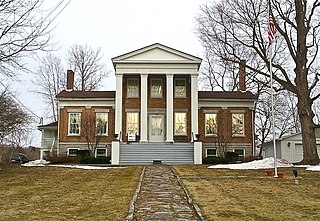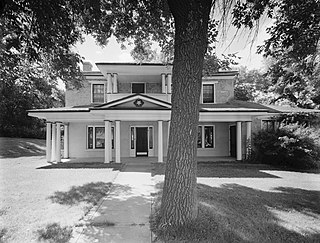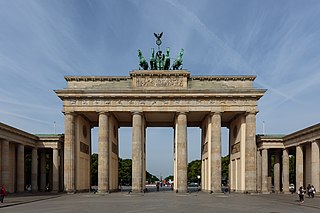
The Mormon Trail is the 1,300-mile (2,092 km) route that members of The Church of Jesus Christ of Latter-day Saints traveled from 1846 to 1868. Today, the Mormon Trail is a part of the United States National Trails System, known as the Mormon Pioneer National Historic Trail.

Tortilla Flat is a small unincorporated community in far eastern Maricopa County, Arizona, United States. It is located in the central part of the state, northeast of Apache Junction. It is the last surviving stagecoach stop along the Apache Trail. According to the Gross Management Department of Arizona's main U.S. Post Office in Phoenix, Tortilla Flat is presumed to be Arizona's smallest official "community" having a U.S. Post Office and voter's precinct. The town has a population of 6. Tortilla Flat can be reached by vehicles on State Route 88, via Apache Junction.

Fulton Ferry is a neighborhood in the New York City borough of Brooklyn. The neighborhood is named for Fulton Ferry, a prominent ferry line crossing the East River between Manhattan and Brooklyn, and is also the name of the ferry slip on the Brooklyn side. The neighborhood is part of Brooklyn Community Board 2. The Fulton Ferry District is a national historic district listed on the National Register of Historic Places in 1974. It consists of 15 contributing buildings built between 1830 and 1895. They are an assortment of commercial and commercial / residential brick buildings ranging from two to four stories in height, with one eight story building. That building is the Eagle Warehouse, a Romanesque Revival style building built by The Brooklyn Eagle in 1893. The district is bisected overhead by the Brooklyn Bridge. Today the area holds many popular attractions such as Pier One of Brooklyn Bridge Park and Grimaldi's Pizzeria. Bargemusic, a concert venue, is moored there today; the Brooklyn Ice Cream Factory sits on the pier. Manhattan ferry service returned in 2006 at the next pier to the north.

Harpers Ferry National Historical Park is located at the confluence of the Potomac and Shenandoah rivers in and around Harpers Ferry, West Virginia. The park includes land in the Shenandoah Valley in Jefferson County, West Virginia; Washington County, Maryland and Loudoun County, Virginia. The park is managed by the National Park Service, an agency of the U.S. Department of the Interior. Originally designated Harpers Ferry National Monument in 1944, the park was declared a National Historical Park by the U.S. Congress in 1963. The park includes the historic town of Harpers Ferry, notable as a center of 19th-century industry and as the scene of John Brown's failed abolitionist uprising. Consisting of almost 4,000 acres (16 km2), it includes the site of which Thomas Jefferson once wrote, "The passage of the Potomac through the Blue Ridge is perhaps one of the most stupendous scenes in Nature" after visiting the area in 1783. Due to a mixture of historical events and ample recreational opportunities, all within 50 miles (80 km) of Washington, D.C., the park was listed on the National Register of Historic Places on October 15, 1966. The Park's Superintendent is presently Tyrone Brandyburg.

Knights Ferry is an unincorporated historic community in Stanislaus County, California, United States. Nestled in the foothills of the Sierra Nevada, it is about 40 miles (64 km) east of Modesto on the Stanislaus River. The Willms Ranch, a California Landmark near the town, was one of many filming locations for the television series Bonanza and Little House on the Prairie. It is home to the Knights Ferry Bridge, the longest covered bridge west of the Mississippi at 330 feet (100 m) in length. Today, it is home to a top-rated K-8 Elementary School, and a museum about the history of the town and also about local wildlife. The town's ruins include a mill and a jail.

Colbert's Ferry was an important Red River crossing between Texas and Indian Territory from about 1853 to 1899. Both the Texas Road and the Butterfield Overland Mail route crossed here. It was located on the Texas Road about 3 miles (4.8 km) southeast of present–day Colbert, Bryan County, Oklahoma. The nearest town on the Texas side of the river is Denison.

Grinter Place is a house on the National Register of Historic Places above the Kansas River in the Muncie neighborhood of Kansas City, Kansas.

Transportation in Omaha, Nebraska, includes most major modes, such as pedestrian, bicycle, automobile, bus, train and airplane. While early transportation consisted of ferries, stagecoaches, steamboats, street railroads, and railroads, the city's transportation systems have evolved to include the Interstate Highway System, parklike boulevards and a variety of bicycle and pedestrian trails. The historic head of several important emigrant trails and the First Transcontinental Railroad, its center as a national transportation hub earned Omaha the nickname "Gate City of the West" as early as the 1860s.

The Reverend George B. Hitchcock House is a historic house museum in Cass County, Iowa, near the city of Lewis. Built in 1856 by the Congregationalist minister George B. Hitchcock, it has features indicative of its use as a "station" on the Underground Railway, corroborated by documentary evidence of Hitchcock's involvement in the shelter and transport of escaped slaves. It was declared a National Historic Landmark in 2006. It now houses a museum.

Warner's Ranch near Warner Springs, California, was notable as a way station for large numbers of emigrants on the Southern Emigrant Trail from 1849 to 1861, as it was a stop on both the Gila River Trail and the Butterfield Overland Mail stagecoach line (1859-1861). It also was operated as a pioneering cattle ranch.

The path followed by the Oregon Trail, California Trail and Mormon Trail spans 400 miles (640 km) through the U.S. state of Wyoming. The trail entered from Nebraska on the eastern border of the state near the present day town of Torrington and exited on the western border near the towns of Cokeville and Afton. An estimated 350,000 to 400,000 settlers traveled on the trail through Wyoming between 1841 and 1868. All three trails follow the same path through most of the state. The Mormon Trail splits at Fort Bridger and enters Utah, while the Oregon and California Trails continue to Idaho.

The Allstadt House and Ordinary was built about 1790 on land owned by the Lee family near Harpers Ferry, West Virginia, including Phillip Ludwell Lee, Richard Bland Lee and Henry Lee III. The house at the crossroads was sold to the Jacob Allstadt family of Berks County, Pennsylvania in 1811. Allstadt operated an ordinary, or tavern in the house, and a tollgate on the Harpers Ferry-Charles Town Turnpike, while he resided farther down the road in a stone house. The house was enlarged by the Allstadts c. 1830. The house remained in the family until the death of John Thomas Allstadt in 1923, the last survivor of John Brown's Raid.

The Lee's Ferry and Lonely Dell Ranch Historic District includes the ranch homesteaded by Mormon pioneer John D. Lee at Lee's Ferry, Arizona, and now in Glen Canyon National Recreation Area. It is notable for its association with Lee, the ferry and the ranch's extensive irrigation facilities. The district was originally designated the Lonely Dell Ranch Historic District on the National Register of Historic Places in 1978, but was expanded to include Lee's Ferry in 1997.

The Tefft-Steadman House in Marcellus, New York is a Greek Revival-style house that was designed by major architect Minard Lafever.

The Big House in Moccasin, Arizona was built ca. 1875 by Mormon pioneer craftsmen associated with the Mormon United Order based in Orderville, Utah. The house was one of the first multi-room residences in the remote northern Arizona community of Moccasin and for several decades served as a community and religious center for Moccasin and Arizona Strip residents and visitors. Many travelers on the Mormon Honeymoon Trail stayed in the Big House.

The Hampton's Ford Stage Stop and Barn is a historic district in northeastern Box Elder, Utah, United States, that is listed on the National Register of Historic Places.

The Nishnabotna River Bridge is a Warren Pony truss bridge located southwest of Henderson, Iowa, United States. It spans the Nishnabotna River for 284 feet (87 m). The Warren Pony truss bridge was designed by engineers at the Iowa State Highway Commission in the summer of 1929. It was built by McCormack Construction Company of Lohrville, Iowa for $30,900, and completed in 1930. The bridge is made up of two skewed trusses that are supported by concrete abutments and piers. It was listed on the National Register of Historic Places in 1998.

The Nishnabotna River Bridge is located northeast of Manilla, Iowa, United States. It carries traffic on T Avenue over the Nishnabotna River. Steel was in short supply during World War II as a part of the war effort. Many bridges built across the state were built in this era with timber, especially small-scale bridges. Heavy flooding washed out 27 bridges and culverts in Crawford County in May 1945. The county board of supervisors used emergency funds to build new bridges. They bought several steel superstructures from the Des Moines Steel Company to replace the wash-out spans. The bowstring arch-truss structures appear to have been designed by H. Gene McKeown, a civil engineer from Council Bluffs. This bridge is one several similar structures built in the county, and one of five that still remain. The bridge was listed on the National Register of Historic Places in 1998.

The Nishnabotna River Bridge is located southwest of Manilla, Iowa, United States. It carries traffic on 310th Street over the Nishnabotna River. Steel was in short supply during World War II as a part of the war effort. Many bridges built across the state were built in this era with timber, especially small-scale bridges. Heavy flooding washed out 27 bridges and culverts in Crawford County in May 1945. The county board of supervisors used emergency funds to build new bridges. They bought several steel superstructures from the Des Moines Steel Company to replace the wash-out spans. The bowstring arch-truss structures appear to have been designed by H. Gene McKeown, a civil engineer from Council Bluffs. This bridge is one several similar structures built in the county, and one of five that still remain. The bridge was listed on the National Register of Historic Places in 1999.

The Capitol Boulevard Memorial Bridge, also known as the Oregon Trail Memorial Bridge, is a historic bridge over the Boise River in Boise, Idaho, United States, the is listed on the National Register of Historic Places.

























